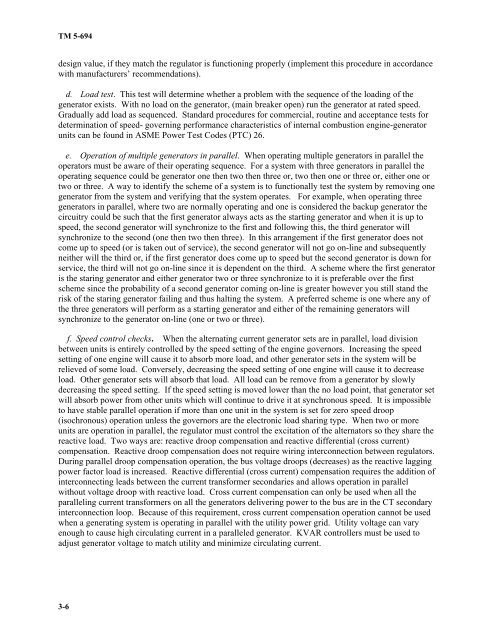Commissioning of Electrical Systems for Command, Control
Commissioning of Electrical Systems for Command, Control
Commissioning of Electrical Systems for Command, Control
Create successful ePaper yourself
Turn your PDF publications into a flip-book with our unique Google optimized e-Paper software.
TM 5-694<br />
design value, if they match the regulator is functioning properly (implement this procedure in accordance<br />
with manufacturers’ recommendations).<br />
d. Load test. This test will determine whether a problem with the sequence <strong>of</strong> the loading <strong>of</strong> the<br />
generator exists. With no load on the generator, (main breaker open) run the generator at rated speed.<br />
Gradually add load as sequenced. Standard procedures <strong>for</strong> commercial, routine and acceptance tests <strong>for</strong><br />
determination <strong>of</strong> speed- governing per<strong>for</strong>mance characteristics <strong>of</strong> internal combustion engine-generator<br />
units can be found in ASME Power Test Codes (PTC) 26.<br />
e. Operation <strong>of</strong> multiple generators in parallel. When operating multiple generators in parallel the<br />
operators must be aware <strong>of</strong> their operating sequence. For a system with three generators in parallel the<br />
operating sequence could be generator one then two then three or, two then one or three or, either one or<br />
two or three. A way to identify the scheme <strong>of</strong> a system is to functionally test the system by removing one<br />
generator from the system and verifying that the system operates. For example, when operating three<br />
generators in parallel, where two are normally operating and one is considered the backup generator the<br />
circuitry could be such that the first generator always acts as the starting generator and when it is up to<br />
speed, the second generator will synchronize to the first and following this, the third generator will<br />
synchronize to the second (one then two then three). In this arrangement if the first generator does not<br />
come up to speed (or is taken out <strong>of</strong> service), the second generator will not go on-line and subsequently<br />
neither will the third or, if the first generator does come up to speed but the second generator is down <strong>for</strong><br />
service, the third will not go on-line since it is dependent on the third. A scheme where the first generator<br />
is the staring generator and either generator two or three synchronize to it is preferable over the first<br />
scheme since the probability <strong>of</strong> a second generator coming on-line is greater however you still stand the<br />
risk <strong>of</strong> the staring generator failing and thus halting the system. A preferred scheme is one where any <strong>of</strong><br />
the three generators will per<strong>for</strong>m as a starting generator and either <strong>of</strong> the remaining generators will<br />
synchronize to the generator on-line (one or two or three).<br />
f. Speed control checks. When the alternating current generator sets are in parallel, load division<br />
between units is entirely controlled by the speed setting <strong>of</strong> the engine governors. Increasing the speed<br />
setting <strong>of</strong> one engine will cause it to absorb more load, and other generator sets in the system will be<br />
relieved <strong>of</strong> some load. Conversely, decreasing the speed setting <strong>of</strong> one engine will cause it to decrease<br />
load. Other generator sets will absorb that load. All load can be remove from a generator by slowly<br />
decreasing the speed setting. If the speed setting is moved lower than the no load point, that generator set<br />
will absorb power from other units which will continue to drive it at synchronous speed. It is impossible<br />
to have stable parallel operation if more than one unit in the system is set <strong>for</strong> zero speed droop<br />
(isochronous) operation unless the governors are the electronic load sharing type. When two or more<br />
units are operation in parallel, the regulator must control the excitation <strong>of</strong> the alternators so they share the<br />
reactive load. Two ways are: reactive droop compensation and reactive differential (cross current)<br />
compensation. Reactive droop compensation does not require wiring interconnection between regulators.<br />
During parallel droop compensation operation, the bus voltage droops (decreases) as the reactive lagging<br />
power factor load is increased. Reactive differential (cross current) compensation requires the addition <strong>of</strong><br />
interconnecting leads between the current trans<strong>for</strong>mer secondaries and allows operation in parallel<br />
without voltage droop with reactive load. Cross current compensation can only be used when all the<br />
paralleling current trans<strong>for</strong>mers on all the generators delivering power to the bus are in the CT secondary<br />
interconnection loop. Because <strong>of</strong> this requirement, cross current compensation operation cannot be used<br />
when a generating system is operating in parallel with the utility power grid. Utility voltage can vary<br />
enough to cause high circulating current in a paralleled generator. KVAR controllers must be used to<br />
adjust generator voltage to match utility and minimize circulating current.<br />
3-6
















